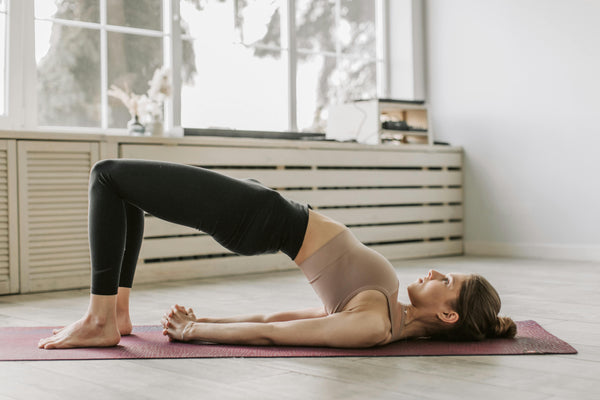
Your Pelvic Floor Deserves More Attention
The pelvic floor is a set of muscles that often doesn’t get the attention it deserves, but these muscles are crucial for women’s health at any age. Whether you’re 20 or 80, caring for your pelvic floor can prevent various issues and help you be more in control of your body 💪.
______________________________________________________________________________________________
What is the pelvic floor? 🤔
Pelvic floor muscles sit between the tailbone and pubic bone and provides support for the bladder, uterus, and bowel. They play a critical role in controlling functions like urinating 🚽, bowel movements 💩, and sexual health ❤️.
When the muscles are weak, problems like bladder leaks, loss of bowel control, and discomfort during sex can appear. So, maintaining a strong pelvic floor is essential for a healthier, more comfortable lifestyle! 🌟
How does the pelvic floor work?
Our pelvic floor muscles enable us to wee, poop, and release gas. By contracting these muscles, our internal organs lift and tighten the openings of the vagina, anus, and urethra. When we relax the muscles, it allows us to go to the toilet freely.
These muscles are also important for sexual function in both men and women. For women, voluntary contractions (or squeezing) can enhance sexual sensation and arousal 🔥. The pelvic floor also supports babies during pregnancy and needs to relax during childbirth.
Why is it important to strengthen our pelvic floor?
Prevent Bladder Leaks 💧
One of the most common signs of a weak pelvic floor is urinary incontinence, or bladder leakage. If you’ve laughed, sneezed, or jumped and experienced a little leakage, you’re not alone!
If you're experiencing bladder leaks, using breathable, absorbent, and skin-friendly incontinence pads, like our Comforts range, can offer added comfort, confidence and reassurance.
Support During Pregnancy 🤰
Pregnancy puts pressure on the pelvic floor as the baby grows. Strengthening these muscles can provide support and ease postpartum recovery. After childbirth, pelvic floor exercises can help rebuild strength and reduce bladder leaks.
After experiencing childbirth, as your body heals and adjusts, Cottons Organic Maternity Pads can offer much-needed comfort and protection. Our maternity pads were designed in conjunction with a leading Australian maternity hospital to ensure our pads are absorbent and provides skin-friendly support during the early postpartum weeks.
Prevent Pelvic Organ Prolapse 🩺
As women age, there’s a risk of pelvic organs shifting out of place, known as prolapse. This can be uncomfortable or sometimes painful. Strengthening the pelvic floor is one of the best ways to prevent this from happening.
Improve Sexual Health ❤️
A strong pelvic floor can enhance sexual health by increasing sensation and leading to better orgasms.
Combat Menopausal Changes 😵💫
Hormonal changes during menopause, particularly the drop in estrogen, can weaken the pelvic floor. Regular exercises can help mitigate these effects and keep your body feeling strong and supported.
If you're needing extra support during peri-menopause, our Cottons Pre-Menopause Pads were designed to help manage the erratic and heavy periods menopause brings.
Signs your pelvic floor needs strengthening
Not sure if your pelvic floor muscles need attention? Look our for these signs:
○ Leaking urine when you laugh, sneeze, or exercise 🏋️♀️
○ Feeling pressure or heaviness in your pelvic area 🔴
○ Frequent or urgent bathroom visits 🚻
○ Discomfort during sex 💔
○ Difficulty controlling bowel movements 💩
If any of this resonates with you, it’s time to focus on those muscles!
3 exercises to get you started 💪
The good news? Pelvic floor exercises are simple and can be done anywhere. Here are a couple to get you started:
1. Kegel Exercises
○ Sit or lie down comfortably.
○ Imagine you’re trying to stop the flow of your wee. Squeeze your pelvic muscles, holding for 5 seconds, then release and repeat.
2. Bridge Pose
○ Lie on your back with your knees bent and feet flat on the floor.
○ Lift your hips while squeezing your pelvic floor muscles, hold for a few seconds, then lower back down and repeat.
3. Squats
○ Stand with your feet shoulder-width apart and lower into a squat position, engaging your pelvic floor muscles as you do.
○ Return to standing and repeat.
If you want to learn more about the pelvic floor, we suggest heading to the Continence Foundation of Australia website! They have incredible resources as well as continence nurses on call ☎️.
_____________________________________________________________________________________________
No matter what stage of life you’re in, strengthening your pelvic floor is a smart choice. It can prevent issues like bladder leaks and pelvic organ prolapse while boosting your confidence in your body 💃. Best of all, you can start these exercises today! So why not give it a try?


